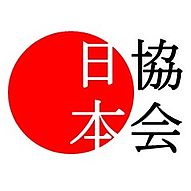
Japan Society 日本協会 Japan-Gesellschaft

日本文化科学技術協会
The Japan Society for Culture, Science and Technology
Japan-Gesellschaft für Kultur, Wissenschaft und Technik
Die Japan-Gesellschaft widmet sich der Weiterentwicklung deutsch-japanischer Beziehungen und setzt sich für eine Vertiefung des gegenseitigen Verständnisses zwischen Deutschland und Japan in einem globalen Kontext ein. Die Hauptziele der Gesellschaft sind (1) die Verbreitung des Wissens und die Verbesserung der Bildung mit Bezug auf Japan, (2) die Förderung des Interesses der Menschen in Japan an Deutschland und seiner Kultur sowie (3) die Weiterentwicklung des kulturellen und wissenschaftlichen Austausches zwischen Deutschland und Japan.
当 日本協会は、独日関係の更なる発展の為、またグローバルな規模で独日の相互理解を深める為に設立されました。この協会の主要な目標は、(1)日本に関する 知識を広め教育を向上する事、(2)日本人のドイツ及びその文化に対する興味を推進する事、(3)独日間の文化および科学交流を進展させる事です。
The Japan Society is dedicated to the enhancement of German-Japanese relationships and committed to deepening mutual understanding between Germany and Japan in a global context. The Society’s main objectives are (1) to promote learning and advance education with regard to Japan, (2) to promote the study of Germany and its culture by Japanese people and (3) to further cultural and scientific exchanges between Germany and Japan.
| Präsident 会長 President | Prof. Dr. Klaus Lange, Regensburg |
| Vizepräsidentinnen 副会長 Vice Presidents | Dr. Yukiko Nakamura, Regensburg Dr. Junko Yabuta, Hamamatsu |
| Beirat 顧問会 Advisory Board | Prof. Dr. Hakusui Aoji, Kyoto |
*******
JAPANESE FOOD CULTURE AND HUMAN HEALTH
Tea in Cardiovascular Health and Disease
Tea is the most widely consumed beverage in Japan. Various findings suggest a protective role of tea and its bioactive constituents in cardiovascular health. While promising results have been found in animal studies regarding the effects of tea on blood pressure and other biomarkers related to the risk of cardiovascular disease, the effects demonstrated in humans have been modest. However, if tea consumption is widespread, even small beneficial effects may alter the population distribution of cardiovascular disease risk, with important public health implications.
Green Tea for the Prevention of Alzheimer's Disease
Numerous mechanisms that may underlie the neuroprotective effects of bioactive compounds found in tea and their preventive efficacy against Alzheimer's disease have been elucidated in animal studies. Clinical results demonstrating similar efficacy in humans are scarce. However, findings from epidemiological studies conducted in Japan suggest that green tea consumption is associated with a reduced risk of age-related cognitive decline and Alzheimer's disease.
Dietary Seaweeds and Obesity
Seaweed, a part of the traditional Japanese diet, contains compounds that may reduce the prevalence of metabolic syndrome. Available evidence suggests potential benefits of seaweed constituents in the management of body weight and obesity. Animal studies have shown that alginate from brown seaweed may increase satiety, reduce energy intake, and support weight loss. Long-term human studies are needed to confirm therapeutic efficacy in the management of overweight and obesity.
Amazake and Its Health Benefits
Amazake ("sweet sake") is a non-alcoholic beverage made from fermented rice and has been consumed in Japan for over a thousand years. It may be a functional food with various health benefits and cosmetic effects. For example, amazake has been found to relieve constipation, and its beneficial effects on skin functions have also been established. Amazake may have further value in relation to various aspects of metabolic health.
Miso as an Antihypertensive Functional Food
Miso is a fermented soybean paste and one of the most traditional and distinctive fermented foods in Japan. It is commonly used in Japan as a condiment in miso soup. Despite its high salt content, no association was found between the frequency of miso soup consumption and blood pressure or the incidence of high blood pressure. Miso is a nutritious fermented food which appears to have health-promoting effects in the management of hypertension.
Self-Care Food Council of Japan
The Self-Care Food Council was established in 2022 with the goal of realizing a healthy and long-lived society through food. Based on the scientific analysis of food ingredients, the Council emphasizes public welfare and strives to create a social system in which every individual can achieve good health. Studies are being conducted to scientifically analyze minor health complaints and link them to nutritional and other food components that could help improve diet and overall health.
Self-Care Initiatives Using Functional Agricultural Products
Current research at the National Agricultural and Food Research Organization (NARO) in Japan investigates the role of functional lunch boxes using local agricultural products in the prevention of lifestyle-related diseases. Consistent use of the functional lunch box was found to be associated with a significant reduction in visceral fat.
*******
JAPANESE FOOD CULTURE AND GASTRONOMY
Matcha, Powdered Green Tea
Matcha is a finely ground powder of specially grown and processed tea leaves. It is consumed differently from tea leaves or tea bags because it is suspended in a liquid, typically water or milk. Matcha is an indispensible part of the Japanese tea ceremony (chanoyu), which focuses on preparing, serving and drinking matcha as hot tea and embodies a meditative spirituality. Today, it is used in a wide variety of foods and beverages, including ice cream, cakes, confectionery and coffee drinks.

Edible Seaweed
Most edible seaweeds or sea vegetables are marine algae, some of which are used for culinary purposes in Japan. Seaweed is a good source of nutrients, such as protein, vitamins, minerals and fiber.
Kombu is used to add umami flavor to Japanese cuisine and is a major ingredient in dashi soup stock. It can be added to dishes or enjoyed as a snack or kombu tea.
Nori is a dried edible seaweed with a strong and distinctive flavor. It is usually pressed into thin, paper-like sheets used to wrap sushi rolls or onigiri (rice balls).
Wakame leaves have a subtly sweet flavor and silky texture. Wakame is sold dried or salted and used in a variety of dishes, including soups and salads.
Udon Noodles
Udon are thick noodles made from wheat flour, salt and water, with a chewy texture. They can be served in a variety of ways, but the most common is as a hot noodle soup, where cooked udon noodles are served in a savory broth. The standard broth varies by region, with dark soy sauce added in eastern Japan and light soy sauce in the west. Common toppings include chopped spring onions, tempura shrimp, deep-fried tofu pouches and sliced fish cake. Udon comes in many regional varieties and serves as a signifier of local identity, with specialty udon restaurants throughout Japan.
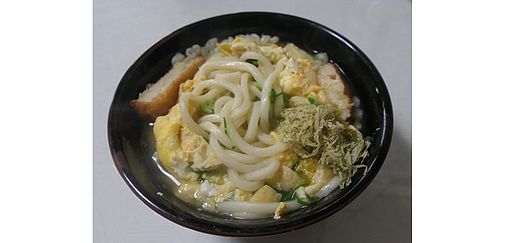
Takoyaki, Fried Octopus Balls
Takoyaki is a 3-4 cm ball-shaped Japanese snack made from a wheat flour-based dough filled with diced or minced octopus, spring onions, pickled ginger and tempura scraps. It is cooked in a special cast-iron pan, resulting in a crisp, golden brown exterior and a soft, moist interior. Takoyaki balls are typically topped with condiments such as Japanese barbecue sauce, mayonnaise, bonito flakes and seaweed powder. Takoyaki is believed to have originated in Osaka in the 1930s. It is particularly popular as a street food and is now ubiquitous throughout Japan.
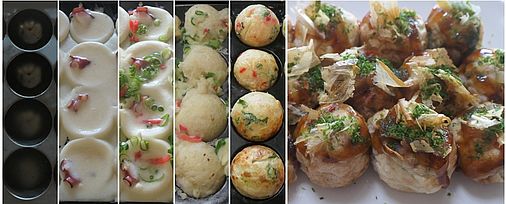
Nabe Hot Pot
Nabe(mono) are stews and soups served while still boiling and kept hot at the table by portable stoves. Common ingredients include vegetables, mushrooms, tofu, meat and seafood. Nabe is usually eaten in winter. Clay or thick cast-iron pots are placed in the center of the dining table and shared by several people. It is popular to eat nabe at home, but it is also served in some restaurants or as part of a ryokan dinner.
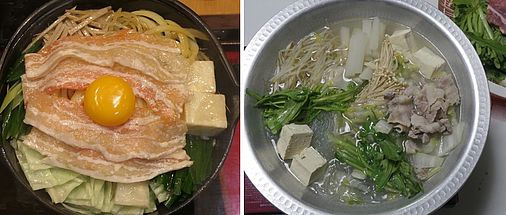
Okonomiyaki, Savory Pancakes
Okonomiyaki is a savory pancake dish made from wheat flour batter and other ingredients cooked on a flat iron griddle. Common additions inclode cabbage, other vegetables, meat and seafood, and toppings include Japanese-style barbecue sauce, dried seaweed flakes, bonito flakes, Japanese mayonnaise and pickled ginger. Okonomiyaki is nationally recognized as being associated with Osaka and Hiroshima. It is a common street food in Japan, but it is also easy to make at home.
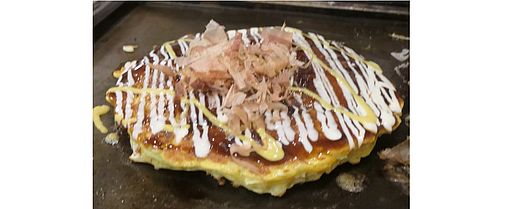
*******
Ancient Sue Pottery Kilns in Semboku, Sakai
Sue ware (Sueki) is a blue-gray, high-fired form of unglazed stoneware made using techniques from the Korean peninsula. Sue ware was produced in many places in Japan between the 5th and 12th centuries. Originally, there were over 1000 kilns dug into hillsides, mainly in the Semboku area of present-day Sakai. Initially used for funerary and ritual objects, Sue pottery later became a utility ware.
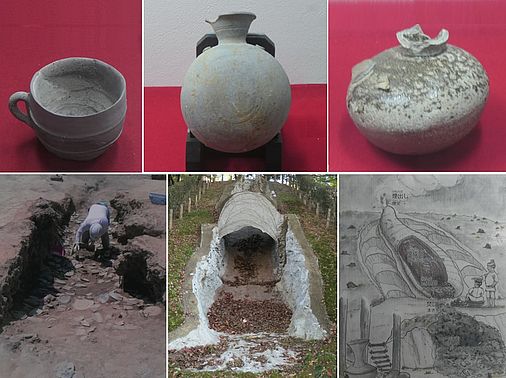
Heijokyo, Ancient Capital of Japan in Nara (UNESCO World Heritage)
Heijokyo was the capital of Japan during the Nara period in the 8th century. The city was modeled after Chang'an, the capital of Tang Dynasty China. In Heijokyo, merchants and traders from China, Korea and India introduced various foreign cultures through the Silk Road. As a result, Heijokyo flourished as Japan's first international and political capital.
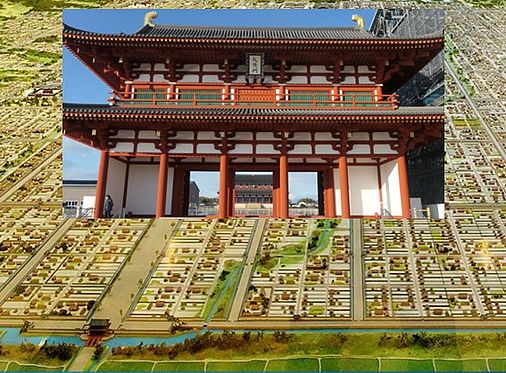
Kasuga-Taisha Shrine in Nara (UNESCO World Heritage Site)
The Forest Where the Gods Dwell - 神宿る森 - Der Wald, in dem die Götter wohnen.
Kasuga-Taisha is an important Shinto shrine. The path leading up to the shrine, which has many stone lanterns, passes through a deer park. The deer are believed to be sacred messengers of the Shinto gods who inhabit the shrine and the surrounding forest and mountainous terrain.
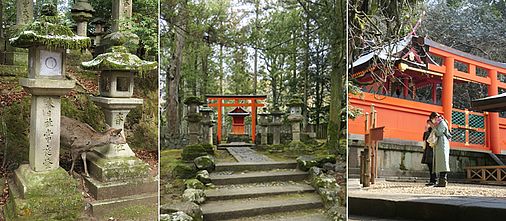
Shikina-en Royal Garden in Naha, Okinawa (UNESCO World Heritage)
Shikina-en Stroll Garden is located south of Shuri Castle in Naha. It was built in the late 18th century as the second residence of the Ryukyu royal family during the Ryukyu Kingdom era. At the heart of the garden is the Royal Palace. Shikina-en is a blend of Chinese and Japanese design and features and has been recognized as "uniquely Ryukyuan" by UNESCO.

Horyuji Temple in Ikaruga, Nara (UNESCO World Heritage Site)
The Horyuji Temple complex is the oldest continuously active Buddhist sanctuary in Asia. It includes some of the oldest and largest wooden buildings in the world. Horyuji was founded in the early 600s by Prince Regent Shotoku Taishi. The construction of the temple marked the introduction of Buddhism and Buddhist art and architecture to Japan from China.
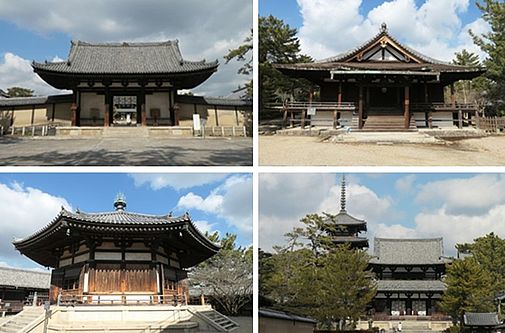
Sakura on Mount Yoshino (Yoshinoyama) (UNESCO World Heritage)
Mount Yoshino in Nara Prefecture has been revered as sacred place for mountain worship since the 7th century. It has been Japan's most famous cherry blossom site for many centuries. The mountain is covered with thousands of cherry trees of many different varieties. The cherry blossoms keep the region in bloom for over a month from late March to mid-April.
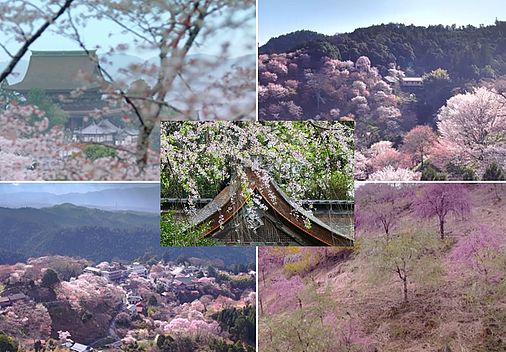
*******
** 10 Jahre Japan-Gesellschaft für Kultur, Wissenschaft und Technik **


